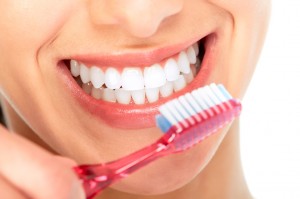 You may think you take excellent care of your teeth and expect to ace that routine dental appointment — only to find that you have a cavity, irritated gums, or another problem. You may think to yourself, I brush twice a day, floss and use mouthwash! How could this have happened? Well, are lots of little nuances involved in taking care of your teeth that you may not be thinking of. Below, we’ve listed the best oral care routine to follow for the healthiest smile year in, year out.
You may think you take excellent care of your teeth and expect to ace that routine dental appointment — only to find that you have a cavity, irritated gums, or another problem. You may think to yourself, I brush twice a day, floss and use mouthwash! How could this have happened? Well, are lots of little nuances involved in taking care of your teeth that you may not be thinking of. Below, we’ve listed the best oral care routine to follow for the healthiest smile year in, year out.
1. Floss First
Flossing helps remove particles of food that your bush just can’t reach. Dislodging these particles allows toothpaste and mouthwash to reach areas between your teeth that would have otherwise been blocked off, and brushing after flossing can help remove any particles that the floss dislodged but didn’t leave your mouth.
It’s also extremely important to floss using the proper technique. Not sure how? Check out our quick primer here. Just follow those simple steps, and be sure to take your time. Rushing will only leave particles behind, and that’s what can lead to tooth decay and tartar.
2. Brush Up On Brushing
Brushing your teeth is easy, but requires a little more thought than just swishing some toothpaste for a few seconds. First of all, make sure you have a soft-bristled brush, and you slowly (and softly!) brush in small circles all around your teeth. Gentleness here is key, as aggressive brushing can damage your enamel and won’t get your teeth any cleaner. We suggest first brushing the outsides of your teeth, then the tops, and then the back. Be sure to also brush your gums and your tongue to help remove additional bacteria that may be lingering in your mouth — it can really hide anywhere!
You’ll also need to replace your toothbrush every 3-4 months, or whenever the bristles begin to fray. If you have sensitive teeth, make sure you find a toothpaste formula specially designed for your needs to help minimize any discomfort.
3. A Little Mouthwash Goes A Long Way
You may think that brushing and flossing have gotten rid of all of that pesky bacteria and food particles, but there can still be some funky stuff that lingers. A good antiseptic mouthwash can help kill even more germs, and gives your mouth an additional rinse to eliminate any lingering gunk brushing and flossing has dislodged. There are a lot of different formulas on the market (you can check to a list of the ADA’s recommended brands here), but in general all mouthwashes will help kill bacteria that can cause tooth decay, tartar, and gingivitis, and it can also be helpful for people with chronic bad breath.
4. Go Pro
While the steps above will help perfect your at-home oral care routine and will minimize your chances for cavities or other problems, your twice-yearly dental visits are still extremely important. Your dentist and hygienist can clean your teeth in ways that just aren’t possible at home, and they can examine your mouth for problems such as cracks and gum disease. There are also many oral health issues that can be genetic, and while a good oral care routine can help keep these problems at bay, they can still pop up due to that pesky DNA. Your dentist can catch potential issues before they get serious, so team up with your oral care experts for simply unbeatable teeth.
Taking care of your teeth isn’t hard, but it does take some time and technique. When you combine the proper oral care routine with regular cleanings at your dental office, you can minimize any problems that come up along the way. Do you have an oral hygiene issue you want to know more about? Let us know in the comments, or contact DentaLux today!







Leave a Reply